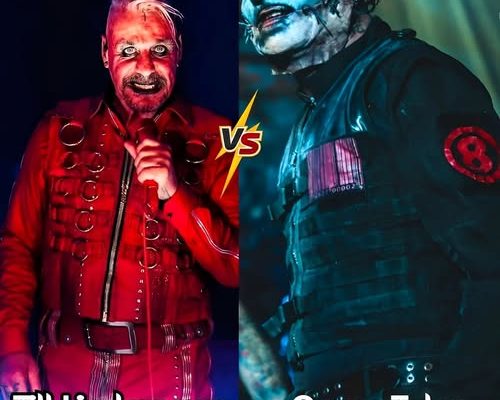In the world of heavy metal, there are few names that command as much awe and respect as Till Lindemann of Rammstein and Corey Taylor of Slipknot and Stone Sour. These two towering figures represent not only different eras and approaches to metal but also contrasting philosophies of performance, songwriting, and fan connection. When people ask who truly reigns supreme in the kingdom of fire and fury that defines the genre, the conversation inevitably narrows to these two icons. Both have left indelible marks on the metal world, both have achieved levels of fame and influence rarely seen in a genre that often prides itself on being outside the mainstream, and both embody different but equally compelling visions of what it means to be a frontman. The debate over who deserves the crown is not simply about vocal talent or stage presence; it is about legacy, artistry, cultural impact, and the ability to define an era of music.
Till Lindemann is a force of nature, a man who towers both physically and metaphorically over his audience. With his deep, operatic growl and his often provocative, theatrical performances, Lindemann has elevated Rammstein from a German industrial band into a global phenomenon. His presence is commanding in a way that few other vocalists can match. When Lindemann walks onto a stage, adorned with military-inspired outfits, flamethrowers strapped to his body, and a dark glimmer in his eye, the crowd knows they are about to witness something beyond music. Rammstein concerts are spectacles, fusing pyrotechnics, shocking imagery, and choreography that blur the line between art and chaos. Lindemann’s lyrics, often sung in German, deal with themes of love, violence, sexuality, politics, and taboo subjects that few dare to touch. While many artists attempt to be controversial, Lindemann exudes a natural aura of danger and unpredictability that makes every performance feel like an event where anything could happen. His mastery of theatricality has made Rammstein concerts some of the most sought-after live experiences in music, drawing audiences that span beyond hardcore metal fans into mainstream culture.
On the other side of the spectrum is Corey Taylor, a vocalist whose versatility and raw emotion have cemented his status as one of the most important figures in modern rock and metal. While Lindemann thrives on grandeur and provocation, Taylor thrives on relatability and intensity. As the frontman of Slipknot, Taylor has been the voice of rage, alienation, and catharsis for millions of fans around the world. His scream is one of the most visceral sounds in metal, capable of tearing through an arena with ferocity, yet he can seamlessly shift into melodic singing that carries haunting vulnerability. With Stone Sour, Taylor explored his more melodic and mainstream side, proving that he is not confined to brutality but can also craft songs that resonate on radio and reach a wider audience. Unlike Lindemann, Taylor’s stage persona is not built on grand theatrics or fire-filled spectacles but on raw human energy and connection. When he screams into the mic, fans feel as if he is screaming for them, with them, and sometimes at them. His lyrics are deeply personal, addressing mental health struggles, identity, resilience, and survival in a world that often feels unforgiving. This makes him not just a performer but a spokesman for an entire generation that grew up with Slipknot as the soundtrack to their inner battles.
The question of supremacy between Lindemann and Taylor ultimately comes down to what one values most in a metal frontman. Lindemann offers spectacle and awe, delivering performances that feel almost mythological. He embodies the concept of metal as theater, an art form that thrives on shock, symbolism, and pushing boundaries. Corey Taylor, on the other hand, embodies metal as catharsis, as a raw outpouring of human struggle and defiance. His connection to fans is deeply personal, almost intimate, despite the ferocious nature of Slipknot’s music. He gives voice to emotions that many people cannot articulate themselves, and in doing so, he has built a loyal following that sees him as more than just a musician but as a kind of brother in arms.
When comparing their vocal abilities, both stand in rare air but in different ways. Till Lindemann’s baritone voice is iconic, instantly recognizable, and carries with it a weight of authority that feels almost Wagnerian in scope. His delivery is deliberate, sometimes terrifying, and always captivating. Corey Taylor, meanwhile, is one of the most versatile vocalists in the genre. His range is astonishing, shifting from guttural growls to soaring clean vocals with ease. Few vocalists in metal—or in any genre—can match his ability to inhabit such diverse styles. In a purely technical sense, Taylor may have the broader toolkit, but Lindemann’s voice is arguably more distinct and emblematic of his band’s identity. If you hear Lindemann, you know you are hearing Rammstein; if you hear Taylor, you might not know at first whether it is Slipknot, Stone Sour, or one of his many collaborations, but you recognize the emotion immediately.
Stage presence is another arena where both men excel, albeit in polar opposite ways. Lindemann is the orchestrator of chaos, conducting massive fire shows, simulated acts of violence and sexuality, and choreographed moments that blur the line between performance and provocation. His stage presence is not about spontaneity but about control, about leading the audience through a carefully curated nightmare that feels larger than life. Corey Taylor’s presence, by contrast, is fueled by spontaneity, energy, and unpredictability. He is constantly in motion, feeding off the crowd’s energy, engaging them directly, and creating a communal experience of shared chaos. Lindemann’s shows are designed for spectatorship; Taylor’s shows are designed for participation. Which one is superior depends on whether you prefer to be awed by a spectacle or consumed by shared fury.
Culturally, both men have left lasting legacies that extend beyond their bands. Rammstein, under Lindemann’s leadership, has become the most successful German-speaking band in the world, proving that language is no barrier to global domination when the music and performance are compelling enough. They have redefined what it means to be a live act, influencing countless bands to think bigger and bolder with their stage productions. Corey Taylor, meanwhile, has become one of the most visible and outspoken figures in metal. Beyond his music, he is known for his interviews, books, and social commentary. He has become a voice for the metal community in mainstream culture, often called upon to defend or explain the genre to outsiders. His outspokenness has made him not just a musician but a cultural commentator, someone who uses his platform to address issues both within and outside of the music world.
Commercially, both have achieved extraordinary success, though in different forms. Rammstein sells out stadiums across Europe and beyond, drawing tens of thousands of fans to every performance, while Slipknot has become one of the biggest metal exports from the United States, with a fanbase that spans generations. Both bands have created identities that are instantly recognizable—the uniforms and masks of Slipknot, the industrial militarism and fire of Rammstein—and both have carved niches that are unique within the broader metal landscape.
At the heart of this debate, however, is the question of what metal itself represents. For some, metal is about theater, about spectacle, about the creation of an alternate world where music, performance, and danger collide in spectacular fashion. For others, metal is about honesty, about channeling raw emotions and building a sense of community through shared struggle. Till Lindemann and Corey Taylor embody these two poles. Lindemann is the high priest of spectacle, Taylor the prophet of catharsis. Neither approach is superior; rather, they highlight the diversity and richness of the metal genre.
So who truly reigns supreme in the kingdom of fire and fury? The answer may ultimately depend on the listener. For those who crave unforgettable visuals, shocking artistry, and performances that border on performance art, Till Lindemann is the king. For those who crave emotional release, relatable storytelling, and a frontman who gives everything of himself to his fans, Corey Taylor is the champion. In truth, both reign supreme in their own domains, and the kingdom of metal is vast enough to hold them both. What makes this debate so compelling is that their greatness lies not in being similar but in being so radically different. Lindemann and Taylor remind us that metal is not one thing but many things: it is theater and fury, spectacle and intimacy, provocation and catharsis. Together, they stand as twin titans whose reigns overlap but never diminish one another, proving that the fire and fury of metal burns brightest when it is expressed in as many forms as possible.



